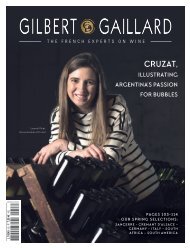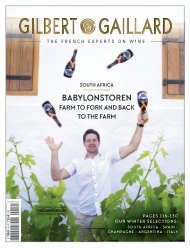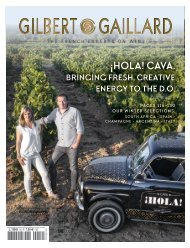FRA_GG_N46-WEB
The GILBERT & GAILLARD International Magazine : Make some room in your lounge for WINE REGIONS from around the world
The GILBERT & GAILLARD International Magazine :
Make some room in your lounge for WINE REGIONS from around the world
Create successful ePaper yourself
Turn your PDF publications into a flip-book with our unique Google optimized e-Paper software.
CHAMPAGNE<br />
– STYLES –<br />
Reserve wines stored in magnums on the lees at Bollinger<br />
Due to climate change, Champagne can no longer<br />
claim to be home to the only vineyards in the<br />
North of Europe. Vines are now grown in the<br />
South of England, Belgium and Luxembourg,<br />
at even more extreme latitudes. But these wine<br />
regions are limited in size, whereas Champagne produces<br />
an average of 230 million bottles a year – at a latitude of<br />
49.5 North! So the first characteristic to remember, and<br />
which stems from a harsh climate, is the freshness in<br />
the wines. This is a direct consequence of very moderate<br />
sunshine – Reims has 1,629 hours a year, compared with<br />
2,069 for Bordeaux.<br />
DISTINCTIVE SOILS<br />
The second trait shared by Champagne wines comes from<br />
the geology of the sub-soils, which are mostly formed<br />
of chalk. Not only do vines thrive on chalk, which acts<br />
as a storage receptacle for water due to its permeability,<br />
it is also essential for those who drink Champagne<br />
because it imparts distinctive minerality. Obviously the<br />
sedimentary outcrops can vary, from chalk to marl and<br />
actual limestone. Admittedly, in the Côte des Blancs<br />
region near Epernay, the chalk forms outcrops, whereas it<br />
WINTER 2021 GILBERT & GAILLARD - THE FRENCH EXPERTS ON WINE 11

















